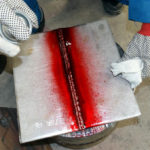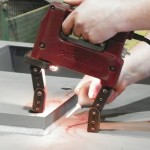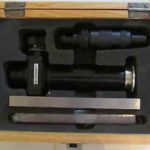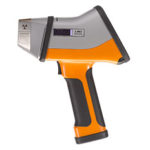P.T, M.T., Brinells Hardness, Positive Material Identification
Penetrant Testing (P.T.) – Based on the properties of capillary action, or the phenomenon of a liquid rising or climbing when confined to a small opening due to surface wetting properties of the liquid, Penetrant testing is used for finding surface breaking discontinuities on relatively smooth, nonporous surfaces. The types of defects that can be found with Penetrant inspection are:

Rolled Products: Penetrant identifies anomalies (cracks, seams or laminations)
Castings: cold shuts, hot tears, porosity, blow holes or shrinkage
Forgings: Illuminating cracks, laps or external bursts
Welds: To identify cracks, porosity, undercut, overlap, lack of fusion or lack of penetration
There are two main types of Penetrant, Fluorescent or Visible. Within each method there are several methods including water washable, postemulsifiable-lipophilic, solvent removal and postemulsifiable-hyperdrophilic. The type and penetrant method are chosen based on sensitivity levels 1-4 and are based on job site conditions and other variables.
Magnetic Particle (M.T.) – Used for finding surface/near surface defects in ferromagnetic material, Magnetic Particle testing (MT) is a versatile inspection method used for field and shop applications. Magnetic particle testing works by magnetizing a ferromagnetic specimen using a magnet or special magnetizing equipment.

If the specimen has discontinuity, the magnetic field flowing through the specimen is interrupted and leakage field occurs. Finely milled iron particles coated with a dye pigment are applied to the specimen. These are attracted to leakage fields and cluster to form an indication directly over the discontinuity. The indication is visually detected under proper lighting conditions.
Brinell Testing -The Brinell scale characterizes the indentation hardness of materials through the scale of penetration of an indenter, loaded on a material test-piece. It is one of several definitions of hardness in materials science.
Proposed by Swedish engineer Johan August Brinell in 1900, it was the first widely used and standardised hardness test in engineering and metallurgy. The large size of indentation and possible damage to test-piece limits its usefulness.
The typical test uses a 10 millimetres (0.39 in) diameter steel ball as an indenter with a 3,000 kgf (29 kN; 6,600 lbf) force. For softer materials, a smaller force is used; for harder materials, a tungsten carbide ball is substituted for the steel ball. The indentation is measured and hardness calculated.
Positive Material Identification (PMI) – Positive Material Identification is a well accepted analytical materials testing and materials identification technique used within the metal alloy industry. It guarantees the materials chemical composition as required for quality control.
On-site Positive Material Identification done by using simple, portable analysers have a number of benefits. For example PMI testing allows the manufacturer to ensure every part conforms to specification, to identify the correct alloy grade where a critical part is to be replaced,
facilitate inward goods inspection to ensure all bought in materials are to specification, etc
Applied correctly, simple Positive Material Identification avoids any potential mix up, costly reworks, out of specification material used incorrectly. PMI testing avoids the failure of a critical component potentially leading, in the  worst case, to a catastrophic failure of a process and loss of life.
worst case, to a catastrophic failure of a process and loss of life.
Positive Material Identification and XRF
The X-MET7000 Series is a rugged handheld XRF analyser for PMI testing. It measure in a few seconds – by simply point and shoot – the key alloying elements in stainless steel and high alloy grades where PMI is most frequently used.
Quality control and assurance of micro alloy steels; aluminium and magnesium alloy analysis
Trace & light element analysis (Magnesium to Sulfur)
Low Chromium analysis, FAC inspection
Wires down to 1mm diameter can be identified
No expensive and bulky helium or vacuum attachment needed
